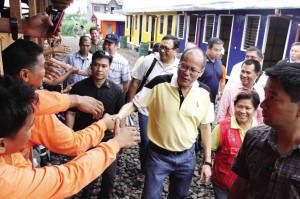‘Yolanda’ shelter project

President Aquino inspects the construction of bunkhouse units in Bliss Kalanipawan during his visit to Tacloban City on Dec. 22, 2013. In the background are the completed bunkhouses. PHOTO COURTESY OF PUBLIC INFORMATION AGENCY REGION 8
MANILA, Philippines—The government is speeding up the construction of bunkhouse units to serve as temporary shelter for victims of Supertyphoon “Yolanda”—but not quite enough.
The Department of Public Works and Highways (DPWH) had promised to build an initial 119 bunkhouses for the typhoon survivors in Eastern Visayas by Dec. 15, and another 23 by Dec. 20.
However, an undisclosed number of contractors hired by the DPWH were able to put up only 86 bunkhouses by Dec. 17.
Only two of them—both in Barangay Candahug in Palo, Leyte—were turned over by President Aquino during his visit to the storm-devastated province last Monday.
The other 84 bunkhouses, including 32 in Tacloban City, still have no running water, according to DPWH Region 8 Director Rolando Asis. He said the recipients of these bunkhouses are still being identified by the Department of Social Welfare and Development.
Article continues after this advertisement“Works on the remaining bunkhouses will most likely resume shortly after the holidays,” Asis told the Inquirer in a phone interview. “That’s early next month, depending on the contractors, contrary to a
Article continues after this advertisementDPWH report which said ‘remaining units will be completed by Dec. 23, 2013.’”
The agency plans to build a total of 228 bunkhouses in Eastern Visayas—50 of them in Tacloban, 50 in Palo town, 46 in Ormoc City, 31 in Samar and 55 in Eastern Samar.
To date, it has already constructed 32 in Tacloban, 19 in Palo, 12 in Ormoc, four in Samar and 19 in Eastern Samar.
High cost
Each bunkhouse, which consists of 24 units with a common bathroom and kitchen, costs P838,000.
The bunkhouses are made of corrugated sheets, plywood and coconut lumber. Each unit measures 8.64 meters.
Public Works and Highways Secretary Rogelio Singson earlier said the government would need at least P15 billion for the construction of temporary shelters for the typhoon survivors.
Asis said the cost of each bunkhouse was high because the construction materials had to be brought in from Cebu City and other parts of the Visayas and Mindanao and the workers also had to travel to the region.
Early this month, the DPWH issued a statement where it assured the public it would go on a “fast-track mode” in the construction of the initial 119 temporary shelters in Leyte and Eastern Samar.
The first batch of bunkhouses, each composed of 24 units or a total of 2,856 units, will be completed by Dec. 15, the agency said.
‘It will take some time’
It also said in Tacloban City, the initial 23 bunkhouses were expected to be finished by Dec. 20.
More will be completed in time for the New Year, the DPWH said.
Singson earlier tasked the DPWH regional directors from Metro Manila, Southern Tagalog, Mimaropa, Bicol, Northern Mindanao, Davao region and Caraga to assist their counterpart from Eastern Visayas in the rehabilitation of typhoon-damaged public infrastructures in the region.
“The repair and rehabilitation of roads, bridges and other state infrastructures can be completed in one year,” Singson said. “But it’s the shelter program that will take some time. Putting up the bunkhouses and other temporary shelters will most likely take three years, which is fast enough.”
Singson said the agency’s “Shelter Action Plan” would require the employment of a lot more construction workers than currently available.
That is why the department had asked the Technical Education and Skills Development Authority (Tesda) to start conducting crash courses on carpentry, equipment operation and other construction-related activities, he said.
“Without these Tesda training courses, we might find ourselves short of construction workers,” he added.
During his latest visit to Leyte, the President said the government would build “permanent houses that are safe for residents.” The bunkhouses, he said, will only be for temporary use.
“You might ask why these are just bunkhouses or temporary houses. We want to ensure first that the areas where we will build the permanent houses are safe,” he said.
The President said he would see to it that the permanent relocation sites of Eastern Visayas residents rendered homeless by the typhoon would be better and more resistant to calamities.